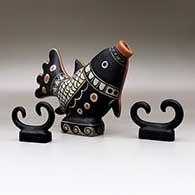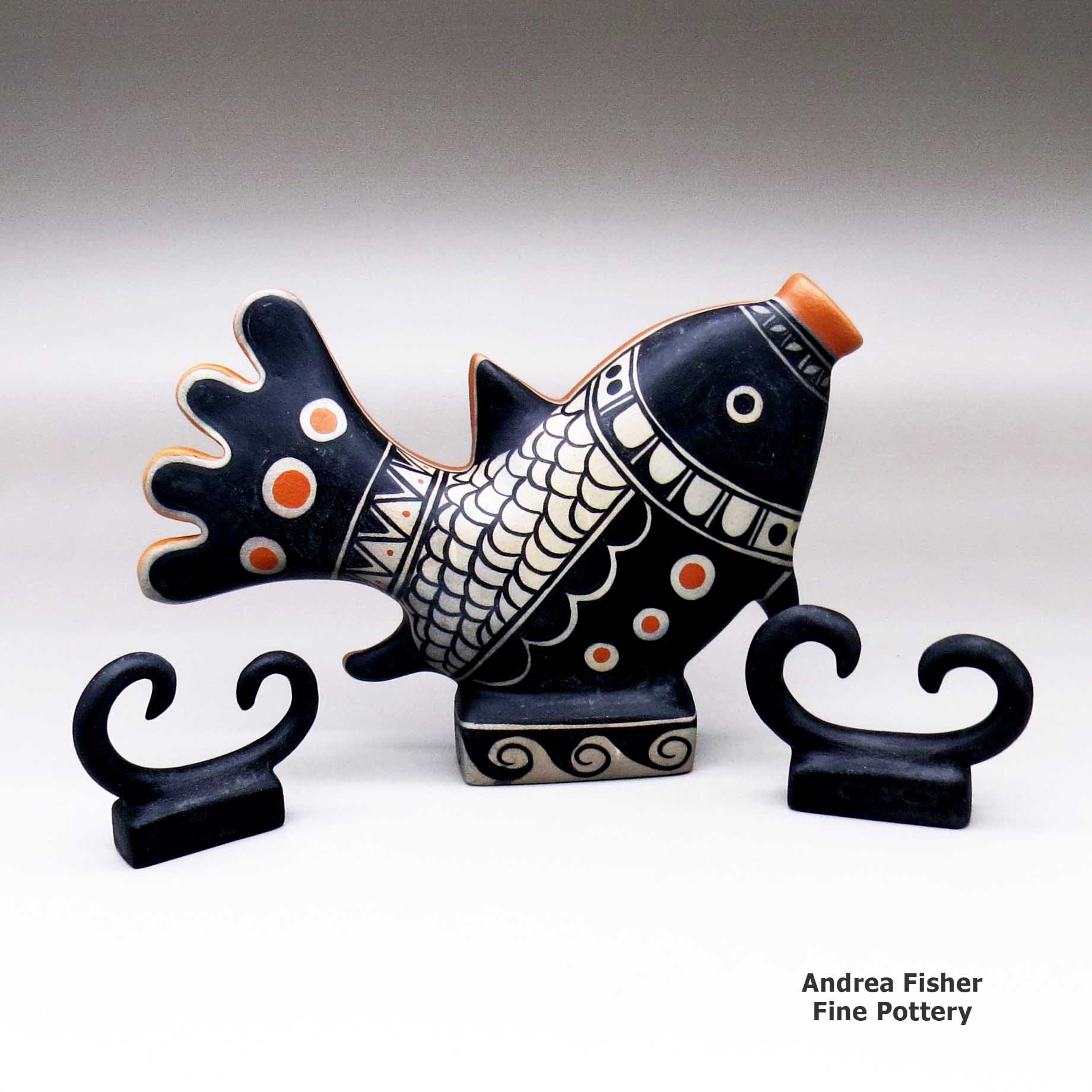
Click or tap to see a larger version
Thomas Tenorio, Santo Domingo, A polychrome three-piece fish-out-of-water
Santo Domingo
$ 1800
zzsd4f321
A polychrome three-piece fish-out-of-water
1.5 in L by 10.25 in W by 7 in H Measurement of fish
Condition: Excellent
Signature: Thomas Tenorio Kewa, NM
Date Created: 2024
Tell me more! Buy this piece!
(505) 986-1234 - www.andreafisherpottery.com - All Rights Reserved
Thomas Tenorio
Santo Domingo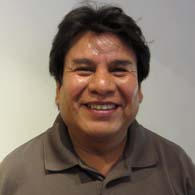

Born in 1963 at Santo Domingo Pueblo, Thomas Tenorio started making pots in the early 1990s. He grew up thinking he came from a family of heishi makers but found out his maternal great-grandmother had made traditional Santo Domingo pots and sold them by the side of the road in the 1940s. Realizing that these days only a few families continue to make Santo Domingo-style pottery he was inspired to learn so that he could help keep the tradition alive.
Thomas tells us he is a self-taught potter: "Nobody showed me how. I learned on my own through a lot of trial and error." He does credit Kenneth Chapman's book The Pottery of Santo Domingo Pueblo for providing him with examples of old Santo Domingo designs.
Thomas uses local Santo Domingo clay which he cleans, mixes, hand-coils, shapes, decorates and then fires outdoors in an open flame, just as his ancestors did for hundreds of years before him. He learned to protect his pots during the firing, surrounding them with a metal cage so no fuel touches them and burns the pot. It took him years to figure out the complicated chemistries of the buff slip and bee weed paint (made from a wild spinach that grows in New Mexico).
Thomas' greatest pleasure comes through recognition of his current work. While he enjoys the process, he "gets lost in the painting and could sit for hours and hours and paint." He especially loves painting the swirls of the water, the wind and the corn. He also loves painting his bowls, especially if they contain fish or the traditional Santo Domingo bird. He is exploring new shapes and designs on his more recent work but he isn't forgetting the traditional shapes and designs of Kewa on his huge pots.
Thomas read somewhere that he was a miniature potter. We laughed when he told us that because he is not a short person and some of his more recent pieces have been almost as big as he is. When we asked him where he gets his inspiration he replied, "My inspiration comes from my traditional faith at home and from nature".
Thomas often participates in the Heard Museum Guild Indian Art Fair (where he won the 2012 First Place ribbon for Traditional Painted Pottery). He won the same First Place award at the Heard in 2007 and has won First and Second Place ribbons at the Santa Fe Indian Market in 2015, 2014, 2011 and 2010.
In 2015 Thomas had an extremely successful one-man show at Andrea Fisher Fine Pottery where he did an outdoor firing for some of our best customers. In 2023 he came to the attention of Travel & Leisure Magazine and they did a full article and video production on Thomas: making and painting his pots, then firing them the traditional way (the pueblo said no outdoor fires all that week, Andrea was able to get a fire permit and they filmed it at her house).
Thomas signs his pottery "Thomas Tenorio, Kewa, NM" and sometimes adds the year.
His pottery can be found in the collections of:
- The White House, Washington, DC
- Rockefeller Museum, New York City
- Smithsonian Institute, Washington, DC
- Museum of Indian Arts & Culture, Santa Fe, NM
- Pueblo Grande Museum, Phoenix, AZ
- Crocker Museum, Sacramento, CA
Some of the Other Awards Won by Thomas
- 2024 Santa Fe Indian Market, Classification IIB: Category 605 - Figures, Manas, Second Place.
- 2023 Santa Fe Indian Market, Classification IIB, Category 603 - Painted polychrome pottery in the style of Cochiti, Santo Domingo, Santa Clara, San Ildefonso, Tesuque, Nambe, San Juan, Pojoaque, Any form, Second Place
- 2023 Santa Fe Indian Market, Classification IIB, Category 605 - Figures/Manas, Second Place
- 2018 Santa Fe Indian Market, Classification II - Pottery, Division B - Traditional Painted Pottery, Category 603 - Painted Polychrome Pottery in the Style of Cochiti, Santo Domingo, Santa Clara, San Ildefonso, Tesuque, Nambe, San Juan, Pojoaque, Any Form: First Place
- 2018 Santa Fe Indian Market, Classification II - Pottery, Division B - Traditional Painted Pottery, Category 603 - Painted Polychrome Pottery in the Style of Cochiti, Santo Domingo, Santa Clara, San Ildefonso, Tesuque, Nambe, San Juan, Pojoaque, Any Form: Second Place
- 2018 Santa Fe Indian Market, Pueblo Pottery Excellence Award. For Creative Excellence in the Use of Traditional Materials and Native Techniques and Designs in Pueblo Pottery
- 2012 Heard Museum Guild Indian Art Fair & Market. Phoenix, AZ. Class. II - Pottery, Div. A - Traditional, native clay, hand build, painted, First Place
- 2010 Heard Museum Guild Indian Art Fair & Market. Phoenix, AZ. Class. II - Pottery, traditional, native clay, hand built, painted, Honorable Mention
- 2008 Heard Museum Guild Indian Art Fair & Market. Phoenix, AZ. Class. II - Pottery, Div. A - Traditional, Native clay, hand built, painted, First Place
Santo Domingo Pueblo
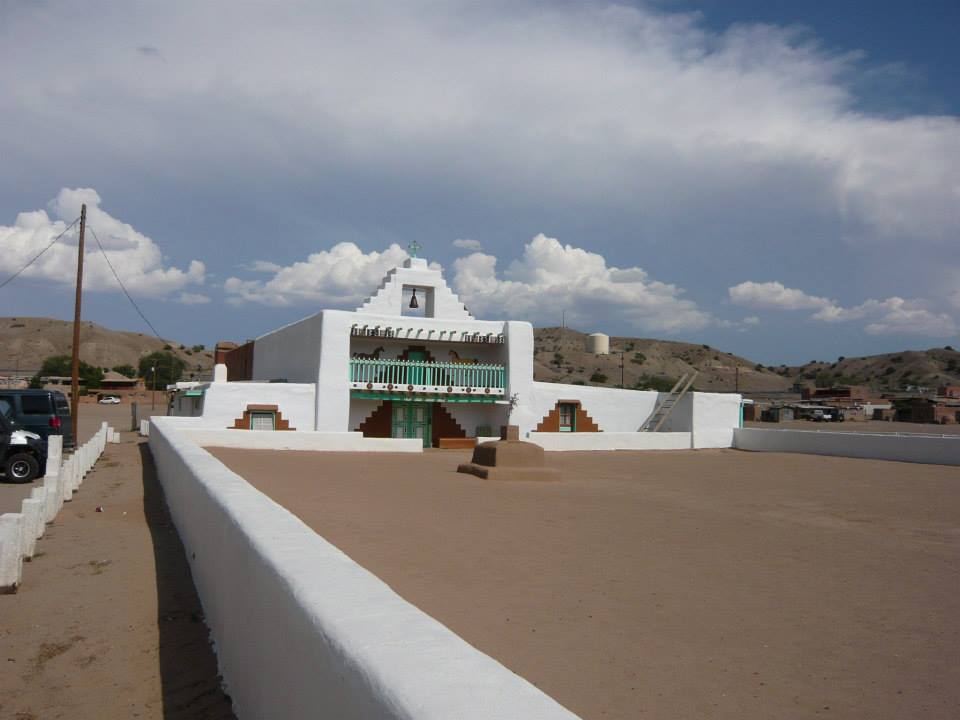
Santo Domingo Pueblo Mission Church
Santo Domingo Pueblo is located on the east bank of the Rio Grande about half-way between Santa Fe and Albuquerque. Historically, the people of Santo Domingo were among the most active of Pueblo traders. The pueblo also has a reputation for being ultra traditional, probably due, at least in part, to the longevity of the pueblo's pottery styles. Some of today's popular designs have changed very little since the 1700s.
In pre-Columbian times, traders from Santo Domingo were trading turquoise (from mines in the Cerrillos Hills) and hand-made heishe beads as far away as central Mexico. Many artisans in the pueblo still work in the old ways and produce wonderful silver and turquoise jewelry and heishe decorations.
Like the people of nearby San Felipe and Cochiti, the people of Santo Domingo speak Keres and trace their ancestry back to villages established on the Pajarito Plateau area in the 1400s. Like the other Rio Grande pueblos, Santo Domingo rose up against the Spanish oppressors in 1680, following Alonzo Catiti as he led the Keres-speaking pueblos and worked with Popé (of San Juan Pueblo) to stop the Spanish atrocities. However, when Spanish Governor Antonio Otermin returned to the area in 1681, he found Santo Domingo deserted and ordered it burned. The pueblo residents had fled to a nearby mountain stronghold and when Don Diego de Vargas returned to Nuevo Mexico in 1692, he attacked that mountain fortress and burned it, too. Catiti died in that battle and Keres opposition to the Spanish crumbled with his death. The survivors of that battle fled, some to Acoma, some to fledgling Laguna, some to the Hopi mesas. Over time most of them returned to Santo Domingo.
In the 1790s Santo Domingo accepted an influx of refugees from the Galisteo Basin area as they fled the near-constant attacks of Apache, Comanche, Ute and Navajo raiders in that area. Today's main Santo Domingo village was founded about 1886.
In 1598 Santo Domingo was the site of the first gathering of 38 pueblo governors by Don Juan de Oñaté to try to force them to swear allegiance to the crown of Spain. Today, the All Indian Pueblo Council (consisting of the nineteen remaining pueblo's governors and an executive staff) gathers at Santo Domingo for their first meeting every year, to continue what is now the oldest annual political gathering in America. During the time of the Spanish occupation Santo Domingo served as the headquarters of the Franciscan missionaries in New Mexico and religious trials were held there during the Spanish Inquisition.
Today, the people of Santo Domingo number around 4,500, with about two-thirds of them living on the reservation. The pottery traditions of the pueblo almost died out after the railroads arrived and many Santo Domingos went to work laying tracks. Even today many Santo Domingo men work as firefighters for the US Forest Service in fire season and practice their artistic talents during the rest of the year.
Potter Robert Tenorio began working to revive the Santo Domingo pottery tradition in the early 1970s. His influence can be found among many of today's Santo Domingo potters, even if they say he only stimulated them to learn on their own.
While today's Santo Domingo pottery is known for designs described as simple geometrics, another outstanding feature is boldness: the lines are thick and well-defined. In the 1920s, Kenneth Chapman, from the Museum of New Mexico, went to Santo Domingo and made drawings of many of the designs that were being painted on Santo Domingo pottery "before they disappeared." Thomas Tenorio said he got most of his designs from that collection.
As religious leaders forbid the representation of human figures as well as other sacred designs on pottery made for commercial purposes, birds, fish and flowers are common design motifs. Depictions of mammals are rarely seen. Another typical Santo Domingo style is to paint in the negative, meaning cover the pot in panels of big swatches of black and red so that only a few lines of the cream slip show through.
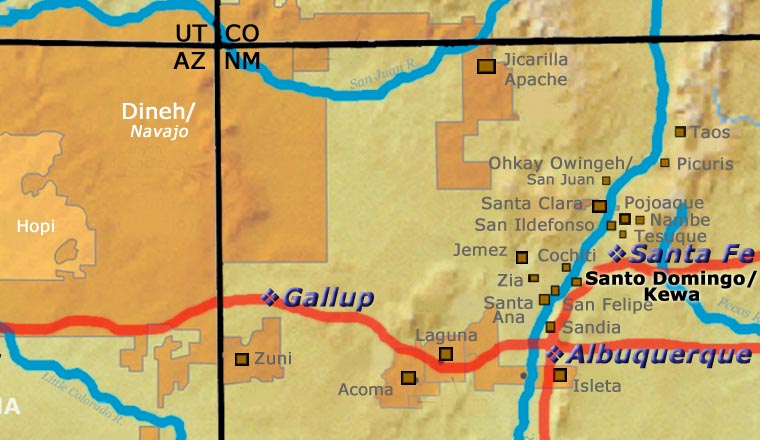
Santo Domingo Pueblo at Wikipedia
Santo Domingo Pueblo official site
Pueblos of the Rio Grande, Daniel Gibson, ISBN-13:978-1-887896-26-9, Rio Nuevo Publishers, 2001
Copyright © 1998-2025 by


